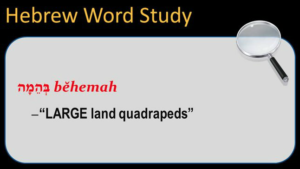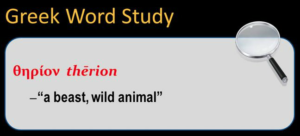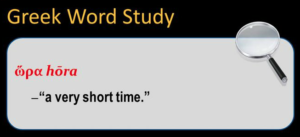Isaiah 13-14, Jeremiah 50-51 and Revelation 18 are the main passages in Scripture which contain the prophecies regarding the total destruction of Babylon. They give many details which will help us to identify the fulfillment and to determine whether this destruction has occurred in the past, or if it is yet to occur in the future.
I think you will see as we study these details, that the destruction of Babylon is not figurative, not symbolic and not allegorical. “Figurative language refers to any words that are used with a meaning other than their common, literal sense” (McQuilken 190).
Common examples of figures of speech often used in Scripture are —Simile, Metaphor, Metonymy, Synecdoche, etc. There may be figures of speech in the prophecies regarding the destruction of Babylon, but the entire prophecy isn’t figurative, and the figures of speech still represent something actual.
“Symbols are one thing taken to represent something else, often a material object representing the intangible” (McQuilken 198). Many times, what each symbol represents is explicitly explained in the Scripture passages. Examples of prophecies that are explicitly symbolic are many of the visions in Zechariah such as Zechariah 5 and many of the visions in Revelation such as Revelation 17.
“Allegorical” means that it has hidden spiritual meaning that transcends the literal sense of the text. This makes the meaning subject to the person reading it who can make it mean anything he or she chooses.
To understand the Isaiah, Jeremiah and Revelation passages, it’s important to read all of them in context and keep the following in mind. Isaiah chapters 13-14 constitute one prophecy (until 14:23-32). Be sure to ignore the chapter breaks, because chapter breaks are man-made and not part of the original manuscripts. The entire prophecy is one unit which was given at one time. Also, within chapter 14, there is a “song” that Israel sings which is one unit within the overall prophecy (14:5-21) and should be considered as a whole.
The final verses 23-32, are a new prophecy regarding Philistia and may or may not be related to the Babylon prophecy.
Jeremiah 50-51 also constitutes one prophecy (until 51:59-64). Again, ignore the man-man chapter break. In chapter 51, verses 59-64 are a description of how Jeremiah wrote the prophecy of Babylon on one scroll, and it also describes what was to be done with the scroll. This further indicates that it was one prophecy given at one time.
Unlike the other passages, Revelation 17 & 18 are divided up correctly. They are two separate prophecies indicated by Revelation 18:1. “And after these things, I saw another angel come down from heaven…”
The focus in Chapter 17 is on the woman who is riding the beast which is thought to represent the overall religious system of Babylon. The rest of the chapter is regarding the beast she is riding on, which isn’t Babylon. Revelation 17 is explicitly symbolic and the interpretation of the symbols are given in the chapter itself, so we will not be reviewing the information in that chapter. Chapter 18 is regarding the literal destruction of the city of Babylon
The three prophets of this event are Isaiah, who according to Isaiah 1:1 was a prophet of Israel during the time of King Uzziah, Jotham, Ahaz, and Hezekiah; Jeremiah, who was a prophet from the days of King Josiah, Jehoiakim, and Zedekiah according to Jeremiah 1:1-3; and, John the Apostle, who wrote the book of Revelation, lived from 6 to 100 AD, and wrote Revelation while on the island of Patmos, during the reign of Roman Emperor Domitian in Revelatin 1:9.
We will see that the destruction of Babylon is a description of an actual, literal event. 1) It is the actual city of Babylon in the land of Chaldea; 2) there are actual nations & troops attacking from the literal North; 3) actual weapons being used to kill actual human beings by the invading troops; and, 4) there is actual physical destruction. Other details include 5) the suddenness of the destruction; 6) the actual results of the destruction; 7) and the purpose for the destruction.
1. The Destruction of the Actual City of Babylon in the Land of Chaldea.
The first point that is made abundantly clear is that it is referring to literal Babylon as indicated by the use of the variations of the phrase “Babylon, in the Land of Chaldea.” If I were to tell you that I’m from Spokane in the land of Washington, you would know that I’m talking about the literal city of Spokane in the State of Washington. These passages are speaking of the literal city of Babylon in the land of Chaldea
The Jewish Encyclopedia states, “The land of the Chaldeans (Jer. xxiv. 5 et al.) is also a frequently occurring phrase. The Chaldean country, in the strict sense, lay in southern Babylonia, on the lower Euphrates and Tigris…” as shown here in the map of the Babylonian Empire.
“…But the name was extended by the Biblical writers to include the whole of Babylonia, after the Chaldean Nebuchadnezzar had established the new Babylonian empire and brought his people to world-wide fame.”
The phrase or variations of the phrase Babylon in the the land of the Chaldeans appears eight times altogether in the Jeremiah and Isaiah passages. It appears in the first verse of Jeremiah’s prophecy regarding Babylon where it says, “This is the message that the Lord spoke through the prophet Jeremiah about Babylon, the land of the Chaldeans.” (Jeremiah 50:1)
Here are the rest of the verses that use that phrase:
- Babylon, that jewel of kingdoms, the splendor and pride of the Chaldeans (Isaiah 13:19)
- Move away from Babylon, and go out of the land of Chaldeans (Jeremiah 50:8)
- The Chaldeans will become plunder (Jeremiah 50:10)
- Heavenly armies will be in the land of Chaldeans (Jeremiah 50:25)
- The slain will fall in the land of Chaldea, pierced through in the streets. (Jeremiah 51:4)
- Before your eyes, I’ll repay Babylon and all the inhabitants of Chaldea (Jeremiah 51:24)
- The sound of a cry is coming from Babylon, great destruction from the land of the Chaldeans (Jeremiah 51:54).
It is clear that this is speaking of a literal place being destroyed. There is no indication that it is meant to be taken figuratively.
Jeremiah 50:21 points out two specific places included in this destruction, they are Merathaim, which is in Southern Mesopotamia, and Pekod, which is a region in Southern Mesopotamia (Jer. 50:21). Both are in the same area as original Chaldea. All of these indicate that the destruction will come upon the literal Babylon in the land of Chaldea.
2. Actual Nations & Troops Attacking from the North
Next, we have actual nations and troops attacking from the North. Jeremiah 51:38 tells us that the Medes, including their governors, the prefects (a chief officer or government official who is responsible for a particular area in a country) and every land under their dominion will come against Babylon (Jeremiah 51:38).
Three Kingdoms under their dominion are specifically named—the Kingdom of Ararat (Armenia/Urartu), Kingdom of Mini (Iran, Part of Syria), Kingdom of Ashkenaz (Scythians/Russians) (Jer. 51:27). They were kingdoms that had been conquered and made vassel states by the Medes (known as the Kurds today) in the early 6th century (Notes 60). And Isaiah 13:17 makes it clear that they are not motivated by financial gain (Silver and Gold)
The troops attacking are mentioned in a number of places in the Jeremiah prophecy. They are called Troops (Jer. 50:14), Warriors (Jer. 50:30; Jer. 51:30, 56) and Soldiers (Jer. 51:14-15; Jer. 50:30, 32). These Nations are Attacking from or out of the North (Isa. 14:31. Jer. 50:3, 9, 41, 51:4) and from afar (Jer. 50:26).
3. Actual Weapons Being Used to Kill Actual Human Beings.
The weapons which are specifically mentioned are:
- Bow (Jer. 51:3-4; 50:14, 42; Isa. 13:18)
- Arrows (Jer. 50:9, 14, 51:11)
- Spears (Jer. 50:41-42)
- Swords (Jer. 50:21)
- Fire and Smoke (Rv. 18:8-9, 18; Jer. 51:32, 58; Isa. 14:31)
Both Isaiah and Jeremiah indicate that actual human beings will be killed—bows dash the young men to pieces, no pity is shown to the unborn, and they will not spare the children (Isaiah 13:18) or the young men. The slain will fall in the land of Chaldea, pierced through in her streets (Jer. 51:3-4) and her warriors will fall in her streets. Her soldiers will be silenced in that day (Jer. 51:30)
4. Actual Physical Destruction
There is also actual physical destruction:
- Walls thrown down (Jer. 50:15)
- Broad wall of Babylon will be completely leveled (Jer. 51:44, 58)
- Its high gate set on fire (Jer. 51:58)
- The bars of the gates broken (Jer. 51:30)
- Pillars have fallen (Jer. 50:15)
- Buildings have fallen (Jer. 50:15)
- Set fire to the city (Jer. 50:32
- Marshes burned with fire (Jer. 51:32)
5. Suddenness of the Destruction
Another detail given is the suddenness of the destruction. Revelation 18:8, 9, 17, and 19 all indicate a sudden destruction and in Revelation 18:8, a voice speaking from heaven states that Babylon’s destruction will come in a single day.
 According to Theyer’s Lexicon, “Heymera” in this case is being used “of the civil day, or the space of twenty four hours.” So the voices literally say that Babylon will be destroyed within one day’s time.
According to Theyer’s Lexicon, “Heymera” in this case is being used “of the civil day, or the space of twenty four hours.” So the voices literally say that Babylon will be destroyed within one day’s time.
All of the other verses are quoting the kings of the Earth who say that her destruction will come in a single hour. According to Thayer’s Lexicon the Greek word “Hora” is being used to indicate a very short time.
One way or the other, this is not contradictory since something that happens in one hour also by definition happens within a single day, but it seems that the voice from Heaven is declaring it will occur in an actual day whereas the kings of the earth are just indicating that it occurs in a relatively short period of time. In addition, Jeremiah 51:8 states, suddenly Babylon fell and was shattered…”
6. Results of the Destruction
The results of the destruction is described as being like Sodom and Gomorrah: (Jer. 50:40; Isa 13:19) in that it will never again be inhabited by human beings (er. 50:13; 51:29, 43), and it will become a home for unclean birds and certain other unclean beasts. It is important to understand that this comparison with Sodom and Gomorrah does not include the method by which Sodom and Gomorrah was destroyed.
Isaiah 13:19-22 lists a number of creatures that will inhabit Babylon. “But desert beasts will lie down there, and their houses will be full of howling creatures; there, owls will dwell, and goat-demons will dance there. Hyenas will howl in its stronghold, and jackals will make their dens in its citadels.”
 One interesting creature is the goat demon, with is translated “satyrs” in the King James version and is defined in the Genesius Hebrew Chaldea Lexicon as “Sa iyr” wood demons, satyrs, resembling he-goats, inhabiting deserts” (Genesius)
One interesting creature is the goat demon, with is translated “satyrs” in the King James version and is defined in the Genesius Hebrew Chaldea Lexicon as “Sa iyr” wood demons, satyrs, resembling he-goats, inhabiting deserts” (Genesius)
Surprisingly, there will be some type of demonic entities. In Rev. 18:2 it states. “Fallen! Babylon the Great has fallen! She has become a home for demons. She is a prison for every unclean spirit, a prison for very unclean bird, and a prison for very unclean and hated beast.”
Moving on to other details, Jeremiah 51:26 indicates that building materials will never be reused. “They won’t get a cornerstone or a foundation stone from you, because you will be a wasteland forever, declares the Lord.”
Other results of the destruction include that God will eliminate from Babylon her name and survivors, her offspring and descendants. (Isa. 14:22). The Chaldeans will come to plunder…she will become the least of the nations, a wilderness, a dry land, and a desert (Jer. 50:10-12)
Babylon will come a heap of ruins, a refuge for jackals, and a desolate place and an object of scorn (Jer. 51:36-38).
7. Purpose for the Destruction
The purpose for the destruction is that it is given as repayment for all the evil that Babylon did in Zion (Jer. 51:24); vengeance for His temple (Jer. 51:11); because she has behaved arrogantly against the Lord, against the Holy One of Israel (Jer. 51:29-30); and because of the slain of Israel (Jer. 51:49)
The Scroll & the Stone
Jeremiah 51:60 states that Jeremiah wrote on a single scroll all the disasters that would come upon Babylon, all these things that were written about Babylon. Jeremiah told Seraiah, “When you come to Babylon, see that you read all these words, and say, Lord, you have declared about this place that you would destroy it so that there wouldn’t be an inhabitant in it, neither human nor animal, because it will be a wasteland forever.”
This declaration that “no animal will inhabit it,” seems to be a contradiction to the earlier description of possible animals inhabiting Babylon after the destruction. In the English language, the word “animal” would be understood to include the entire animal kingdom. This also corresponds to an earlier statement in the Jeremiah prophecy in Jer. 50:3, when it states that no one will live in it—both people and animals will wander off.
 The Hebrew word translated “animals” in both of these passage is the same Hebrew word which is “Behemah” and can be translated—Beast, animal, cattle—as distinguished in the OT from birds, fish, an reptiles.” This term refers to four-footed animals, especially cattle.
The Hebrew word translated “animals” in both of these passage is the same Hebrew word which is “Behemah” and can be translated—Beast, animal, cattle—as distinguished in the OT from birds, fish, an reptiles.” This term refers to four-footed animals, especially cattle.
The Septuagint translates the Hebrew word with the Greek word “Ktenos” which has a very similar definition. “A beast; sp. of a beast of burden, used for four legged animals as opposed to fishes and birds—and the Genesius Hebrew Chaldea Lexion states that it refers to large land quadrapeds.
The Hebrew word “behemoth” is most likely only referring to large land quadrupeds, there is no contradiction to the idea of hyenas, jackals and other creatures still inhabiting Babylon.
 Revelation 18:32 states that it will be a prison for every unclean an hated beast, but the Greek word translated “beast” isn’t the same Greek word that was used to translate “Behemah” in the Jeremiah passage. It is a different kind of beast. Therion is a beast, or a wild animal and it is the same word that is used to describe the Beast of Revelation.
Revelation 18:32 states that it will be a prison for every unclean an hated beast, but the Greek word translated “beast” isn’t the same Greek word that was used to translate “Behemah” in the Jeremiah passage. It is a different kind of beast. Therion is a beast, or a wild animal and it is the same word that is used to describe the Beast of Revelation.
Jeremiah continues in 51:61 “When you finish reading this scroll, tie a rock around it and throw it into the middle of the Euphrates. Then say, “Babylon will sink like this and won’t rise from the disaster that I’m bringing on her. Her people will be exhausted.
Revelation 18:16-17 gives a similar symbolic gesture, “Then a powerful angel picked up a stone that was like a large millstone and threw it into the sea, saying, the great city Babylon will be thrown down violently—and will never be found again.
Summary
The prophecies regarding the destruction of Babylon given in Isaiah 13-14, Jeremiah 50-51 and Revelation 18 give the following details:
The abundance of details makes it clear that this is describing an actual, literal event and it is not symbolic, allegorical or figurative. Anyone should be able to use these details to look for future fulfillment and also to look back in history to see if they have ever been fulfilled in the past.
[Watch the video presentation]



